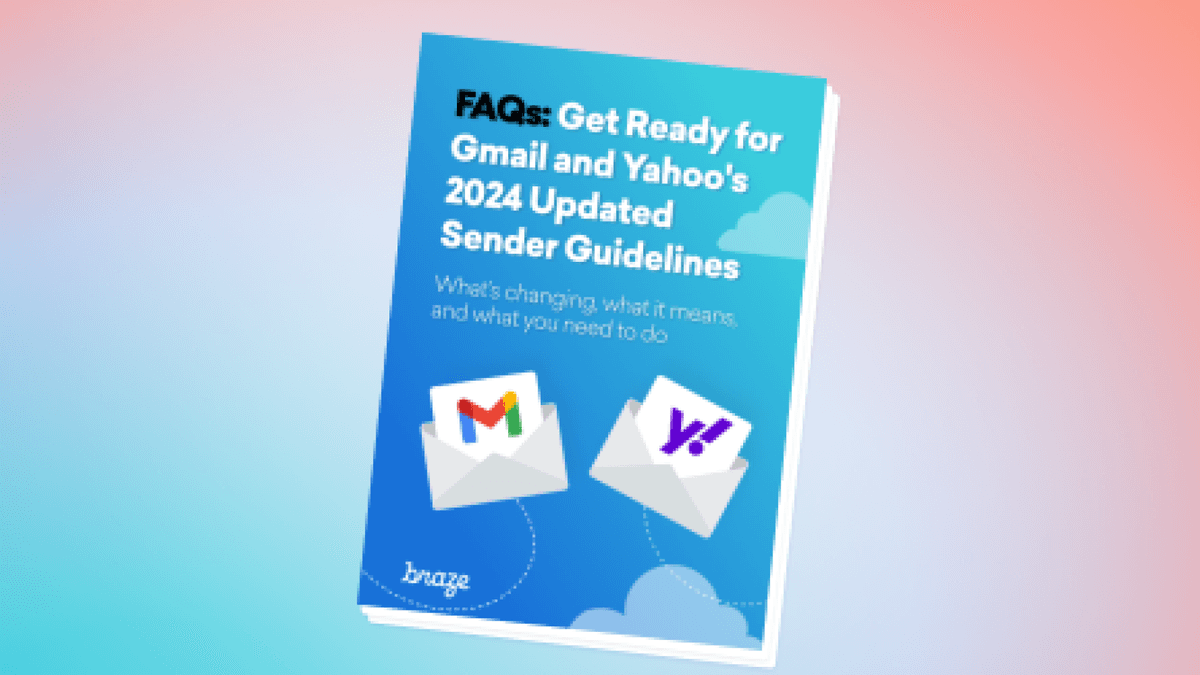Navigating the Latest Email Landscape: Yahoo and Gmail's 2024 New Sending Requirements
Published on November 08, 2023/Last edited on November 08, 2023/5 min read


Kent McGovern
Email Deliverability Principal, BrazeOn October 3, 2023, Yahoo and Gmail separately announced updated requirements to successfully deliver email to their platforms. This announcement aligns with both mail providers’ intention to better secure customers’ inboxes and provide the best consumer email experience. Senders who currently follow best sending practices shouldn’t have too many changes they will need to implement in order to comply with these new requirements.
Yahoo announced that it plans to implement its changes during early 2024, while Gmail plans to implement its changes as of February 1, 2024. An email sender who does not implement Gmail and Yahoo’s new requirements may see a potential impact in its email performance on either platform, including increases in bounce rates that result in delayed or non-delivery of emails, or emails being sent to the designated bulk folder.
The updated recommendations cover the following areas:
Ensure Proper Setup and Authentication
For those senders attempting to send more than 5,000 emails per day to either the Yahoo or Gmail platform, both mail providers will require that all emails be fully authenticated with SPF (Sender Policy Framework), DKIM (Domain Keys Identified Mail), and DMARC (Domain-based Message Authentication, Reporting and Conformance).
Currently, emails sent via the Braze platform include the SPF and DKIM authentication by default; however, in order to comply with these newly announced requirements, senders will be responsible for setting up DMARC. DMARC is the next evolution of authentication protocols. DMARC helps to instruct mailbox providers on how they should handle mail that failed DKIM and SPF authentication checks. Failures could indicate that others are trying to imitate a sender or their email. A sender can tell the mailbox providers to reject or quarantine the mail and even send you automated reports about the bad mail. Yahoo and Gmail have also stated that a DMARC p=none enforcement policy will be acceptable, but it won’t provide any protection if the domain is spoofed. A p=none policy tells the mailbox provider that they should not take action (i.e. reject or quarantine mail attempts that fail).
Additionally, senders will need to ensure that sending domains or IPs have valid forward and reverse DNS records, also referred to as PTR records.
Make it Easy to Unsubscribe
Both providers require a one-click unsubscribe, which should be clearly visible in the body of the email and the list-unsubscribe header, so users can opt out of unwanted messages easily. Enabling users to easily opt out of unwanted messages is also a spam complaint prevention mechanism. Preventing spam complaints helps you to protect your sending reputation and more easily get emails to your intended recipients. Braze senders will want to enable List-Unsubscribe Header feature under Email Preferences. This feature allows you to automatically include a list-unsubscribe header for all emails.
In addition to having the one-click unsubscribe and list-unsubscribe header enabled, both mailbox providers require senders to honor the unsubscribe request within two days. Global legislation can vary on the length of time required to honor an unsubscribe request. We recommend honoring recipients’ requests to be removed as soon as possible, which will help to protect your sending reputation.
Braze supports and is compliant with the one-click unsubscribe requirement. To learn more, see our documentation.
Send Email Your Subscribers Want to Receive
Senders should ensure they are sending emails that their subscribers want to receive and keep their spam complaints to a minimum. Both Yahoo and Gmail will enforce a spam complaint threshold of 0.3% to help reduce spam in their users’ inboxes. Senders who exceed this threshold will likely see an increase in the number of blocked emails or emails being directed to the bulk folder.
Spam complaints are calculated by subscribers clicking on the “Spam” button or moving the email to the spam folder.
Those sending to Gmail should ensure they sign up for Google Postmaster Tools so they can closely monitor their spam complaint rate and reputation directly from Gmail. Braze clients who set up Google Postmaster Tools will also be able to connect their account to the Braze Deliverability Center to monitor their reputation directly in their account.
While it can be a little nerve-wracking when mailbox providers announce new requirements to send to their subscribers successfully, it should be viewed as a positive change. These changes will help push the email industry forward by putting a focus on email authentication and DNS, allowing subscribers to easily unsubscribe from messages, and sending emails to subscribers who truly want to receive them.
Have more questions? Check out the FAQs: Get Ready for Gmail and Yahoo’s 2024 Email Changes guide or watch the on-demand webinar How to Prepare: The Major 2024 Changes Coming to Yahoo and Gmail.
Interested in learning more about how Braze can support stronger deliverability? Check out our look at the Braze Premium Deliverability Services and get in contact with our Sales team.
This document is for informational purposes only. It is not intended to provide, nor may it be relied upon as providing legal advice in any capacity. Bulk email is subject to specific legal requirements. To ensure that you are sending emails in compliance with all applicable laws, rules, and regulations specific to your brand, you should seek the advice of your legal counsel and/or regulatory compliance team.
Related Tags
Be Absolutely Engaging.™
Sign up for regular updates from Braze.
Related Content
View the Blog
How AI Decisioning Transforms Marketing (A Complete Guide)

Team Braze

AI decisioning cheat sheet: How to crawl/walk/run with BrazeAI Decisioning Studioᵀᴹ

Team Braze

A day in the life of a data scientist on the BrazeAIᵀᴹ forward-deployed engineering team
